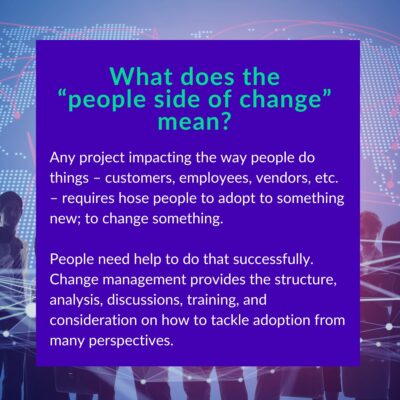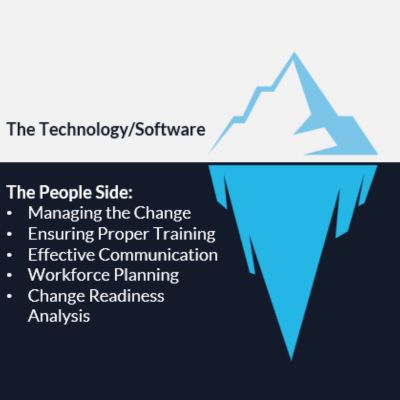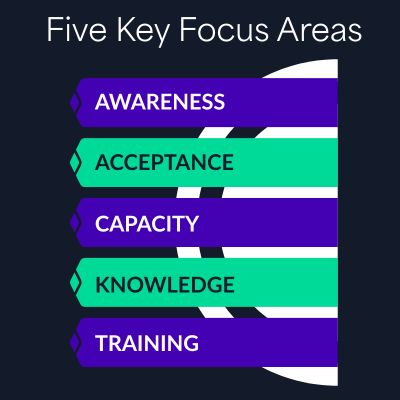Why You Need to include Organizational Change Management in Your Next RFP
Why You Need to include Organizational Change Management in Your Next RFP
People don’t like change. It’s human nature to crave regularity and to stick with behaviors that feel comfortable. This can be particularly true in the public sector, where long-tenured employees and well-established workplace cultures exist.
Resistance to change is a common stumbling block for technology modernization efforts. According to McKinsey, 70% of transformation projects fail because of people issues. It’s the people, not the technology, that impede the mission.
I saw this firsthand recently at a mid-sized government agency when leadership decided to replace a decades-old taxpayer processing system with a modern, cloud-based platform. The technology was sound, the vendor was competent, and the project team worked long hours to meet milestones. But when launch day came, chaos followed. Employees didn’t understand the new workflows, supervisors weren’t equipped to answer questions, and frontline staff reverted to old, manual workarounds.
The issue wasn’t the software—it was the people side of change. No one had taken time to build awareness of why the new system was needed, provide training tailored to different roles, or engage “change champions” to reinforce messaging. Instead of embracing the new tool, employees resisted it, slowing adoption and causing a backlog of work. What should have been a success story turned into months of rework, frustration and extra costs—all because organizational change management had been treated as an afterthought.
Enterprise transformations are people-driven, and are ultimately successful when people, processes, and technology transform together. Technology is only the tip of the iceberg.
That’s why Organizational Change Management (OCM) is mission-critical. OCM facilitates the transition of individuals, teams, and organizations to a future state to achieve business objectives and benefits. That means focusing on people to help them become aware of the change, identify how it impacts their daily work load , determine how they feel about the change, understand the importance of the change, and ultimately adopt the change. OCM helps us plan, manage, mitigate, and reinforce those factors.
Key areas of focus in OCM
Project success is rooted in people who accept, adopt, drive, and sustain change to truly realize the project’s goals and objectives. Organizational change management provides the structure, analysis, discussions, training, and consideration on how to tackle adoption from many perspectives.
There are 5 key focus areas for a change management team that assist users in being ready to adopt to the changes of a project.
- Awareness of the change: Internal & External Communications
- Acceptance of what is changing: Change Readiness Analysis
- Capacity to learn the new way of doing things: Workforce Planning
- Knowledge of the changes they need to adopt: Implementation Planning
- Training to become proficient in the new process/system: Training & Coaching
How and why to include OCM in proposal requests/contracts
Despite its critical role in project success, few federal RFPs include change management deliverables. State and local governments also rarely list OCM as a core requirement. Even when OCM is included, it’s often treated as an add-on, not a core requirement. This results in project risk and stakeholder frustration – leading to delays, rework, and misalignment.
To avoid these pitfalls, agencies should prioritize OCM and seek out partners with proven OCM experience.
We recommend including OCM as a Core Requirement within a Statement of Work and ask potential partners to provide details about change management plans, activities, and methodologies. Partners should define specific outputs and outcomes, including descriptions of
- Readiness Assessment
- Workforce Strategy and Implementation Plan
- Organizational Structure Recommendations
- Communications Strategy and Plan
- Training Strategy and Materials
To implement a robust OCM initiative, agencies should also include the following OCM team roles in their SOW:
Change Manager – Leads overall change management strategy and execution, including coordinating cross-functional activities, monitoring progress, and adjusting the approach accordingly.
Training Lead – Designs and implements training, delivers training sessions and workshops, and assesses learning effectiveness.
Communications Lead – Manages communication strategies, creates messaging materials, and ensures consistent messaging throughout the change.
Workplace Planning SME – Provides expertise on workforce impacts, organizational design, and HR considerations.
Finally, agencies should require vendors to recommend and justify a specific change management methodology. Some methodologies are better suited for certain use cases, so understanding a partner’s rationale for using one approach rather than another is important. For example, here at Voyatek we use Prosci’s ADKAR methodology, which is more focused on managing change at the individual level, on some projects, and the 8-Step Kotter methodology, which is more leadership-centered, on others.
Including Organizational Change Management in your RFP safeguards project success. By making OCM a core requirement, agencies ensure that technology investments are matched with the training, communication, and workforce readiness needed to deliver lasting impact. In the end, it’s not just about implementing new systems—it’s about empowering people to embrace and sustain change.
-Jen Galbreath, Manager, Voyatek




